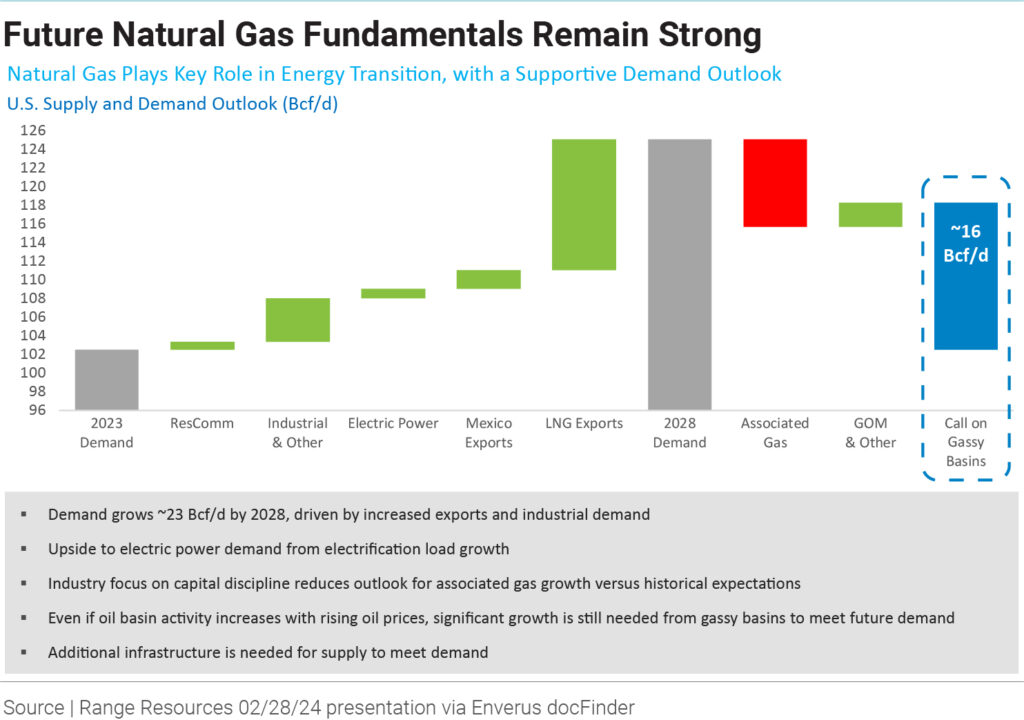Natural gas prices are setting up E&P companies operating in gas plays for a challenging 2024, maybe more challenging than they expected. On March 20, the 12-month strip settled at $2.71/MMBtu, down from more than $3.00/MMBtu when the year started, and the front-month settled at $1.70/MMBtu. The warm winter and growing associated gas production have pushed gas storage volumes 41% above the five-year average and 21% higher than this time last year, at 2.33 Tcf as of March 15.
The vast majority of Appalachian producers announced maintenance production plans at the start of the year, but Chesapeake Energy, which also operates in the Haynesville, is taking a more proactive approach, and EQT Corp. and CNX Resources announced additional measures after their guidance announcements. While companies are certainly protective of cash flow, they all want to be ready to service the next wave of LNG projects coming online in 2025.
Chesapeake cutting TILs by 20% YOY, building 1 Bcf/d in deferred capacity.
Chesapeake is addressing lower natural gas demand by planning to turn in line 20% fewer wells in 2024 than in 2023. In late February, the company had five rigs running in the Hayesville, four in the Marcellus, and four frac crews evenly split between the two plays. One Haynesville rig is being dropped in March, along with a frac crew in each of the plays, and one Marcellus rig will be cut at mid-year. The resulting seven-rig, two-crew activity level will be maintained through year’s end. Chesapeake plans to drill 95-110 wells in 2024 while turning in line only 30-40 wells. In contrast, during 2023 the company drilled 193 wells and turned in line 166 wells. By deferring TILs in 2024, Chesapeake says it will build capital-efficient production capacity that can be utilized when demand recovers. By year’s end, that capacity could be up to 1 Bcf/d. The company’s output will fall 21% YOY at midpoint to a 2024 average of 2.65-2.75 Bcfe/d.
After announcing its 2024 operational plans in February, EQT said March 4 it was curtailing 1 Bcf/d of gross production from late February through March, after which it would reassess the market. Impacts to Q1 net volumes will total 30-40 Bcf, or about 330-440 MMcf/d. However, recent management comments suggest that the current curtailments will not be followed by a pullback in 2024 capex plans.
EQT deferring 1 Bcf/d of production from late February through March.
“Certainly, for a business like EQT, where we’re drilling 15, 20 wells a pad, the capex we spend this year has no real impact on our production this year. It really has an impact on production next year…We’re just not under the same pressure that most of our peers are,” CFO Jeremy Knop said on a Feb. 14 earnings call. “So that allows us to be a little stickier and plan for the long term and not be as reactive. But look, as we said before, our production guidance gives us flexibility to reduce as needed. But reducing capex activity this year is not—I mean, it’d be window dressing this year at the expense of next year, and it’s just not how we run the business.”
On March 12, CNX announced that it was delaying completion of three Marcellus pads containing a total of 11 wells to “avoid bringing incremental volumes into the current oversupplied market.” The company did not say how long the delay would be. Because of the deferrals, CNX lowered its 2024 production guidance by 30 Bcfe at midpoint to 540-560 Bcfe, or 1.48-1.53 Bcfe/d, which would be a modest 1.6% YOY decline at midpoint. Previously, CNX anticipated a slight increase in production compared to 2023.
CNX deferring 11 wells among three pads in the Marcellus.
Companies in the 2024 maintenance category include Antero Resources and Range Resources. Antero is staring sub-$2.00 gas right in the face, as it is unhedged. The company has significant liquids fractions that will enable it to generate free cash flow, it said in February.
“When we construct the capital plan, the first filter is always to generate free cash flow. So, we’re very focused on that,” CFO Michael Kennedy said on a Feb. 15 earnings call when asked if the company could cut back its activity in the face of low prices. “We’re down to two rigs from three rigs. We stacked one of our rigs. So down to a two-rig program and one completion crew. We just released one of our completion crews and made it a spot crew. That spot crew does have one pad that it’s scheduled to complete in the third quarter, and that’s highly flexible and dependent on liquids prices.”
Kennedy said Antero could “toggle lower” on capex by about $50 million through a change in activity levels, adding, “at today’s gas prices, which is about a $2.25 strip, we’re still generating free cash flow.”
Range aims to keep production flat and build a drilled uncompleted well inventory by year’s end. CEO Dennis Degner said on a Feb. 22 earnings call that the company has flexibility.

“If you look back for our ability to basically shape the curve of when our wells will turn in line this year, when you look at the past several years, there have been times when clearly, we’ve chosen to look at shut-in economics,” Degner said. “And we’ve looked at dry gas portions of the field, and we know where, let’s just say, that gas curtailment could take place and have a commensurate cost reduction that goes along with it, while supporting really our price realization uplift associated with our NGLs in the wet side of it.
“So, as we look kind of on the program going forward and the inventory build that would support our setup for 2025, we see that we’ll have the flexibility to basically adjust timing for turn-in-lines based upon what the macro is telling us, and what the basin fundamentals are looking like.”
Coterra pulls back capex by 55% YOY in the Marcellus; volumes to fall 6%.
Multi-basin operator Coterra Energy is spending 55% less YOY on its Marcellus operations, opting to shift spending to liquids-rich opportunities in the Permian and Anadarko basins. At midpoint, the company expects its Marcellus output to fall 6% in 2024 after producing 2.26 Bcf/d in 2023. Gulfport Energy, which also has a multi-basin portfolio, is spending 10% less in the Utica this year but intends to keep volumes flat, with a focus on liquids-rich acreage. “We are remaining flexible in light of the commodity backdrop and possess the ability to moderately defer or accelerate completions, should commodity prices and rates of return warrant,” CEO John Reinhart said on a Feb. 28 earnings call.
About Enverus Intelligence Publications
Enverus Intelligence Publications presents the news as it happens with impactful, concise articles, cutting through the clutter to deliver timely perspectives and insights on various topics from writers who provide deep context to the energy sector.







